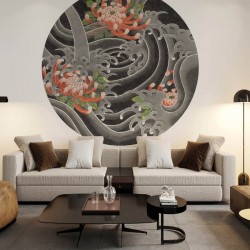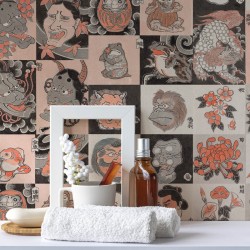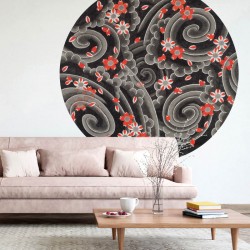The term “Kiku Sui” refers to Chrysanthemum flowers floating in a stream of water. Chrysanthemums called Kiku in Japanese represents longevity, majestic and protection from evil spirits. In the headwaters of a river that flows through a region of China, countless chrysanthemums grow wild, and the drops and dewdrops that fall from the chrysanthemums collect to form a river valley. The people living in the small village of the houses along the river are all long-lived - over a hundred years old. They always drink the water from the river, which contains drops of chrysanthemums, to keep themselves alive.
The chrysanthemum is a symbol of the world of the Divine Immortal, Queen of the Hundred Grasses, and it was believed that drinking its extracts would bring about longevity and immortality.
- Specifications
Premium quality heavy duty 160 grs wallpaper with paper top layer and non woven backing; Colourfast and washable with a soft cloth; No wallpapering table necessary, glue is applied to wall; Fire rating USA ASTM E 84.10 EU B.s1, do.
- Size Description
Circle size: W 191 cm x L 191 cm = 3,65 m2
Circle size: W 75,2" x L 75,2" = 39,27 SqFt
NO REPEAT, NO MATCH!
-
Kensho II
<p>Kensho Ⅱ is a Japanese tattoo master using traditional “Tebori” methods and “Sashibo”instruments. He began apprenticeship with his master Takehisa Muramatsu in 2000. Asked by Takehisa Muramatsu if he would one day like to become a tattoo artist Kesho answered “yes Sensei!” From that point his tattooing career took off. It's very difficult to be given the chance to become a tattoo apprentice in Japan, especially within a traditional Japanese tattoo family.</p> <p>The Japanese apprentice system is very strict. Takehisa Muramatsu never taught Kensho directly - Instead, he watched his technique and studied his drawings for couple years until he received permission to practice Sashibo and Tebori - but not on customers. He trained on various items such as paper, radish, banana, pig skin bought in a supermarket etc. After much practice he ultimately tried the techniques on his own skin and studied what sort of ink mixtures (Japanese traditional tattoo artists make black ink for each appointment) worked and looked better, how much force he should apply for Tebori, etc...</p>


 EUR
EUR























